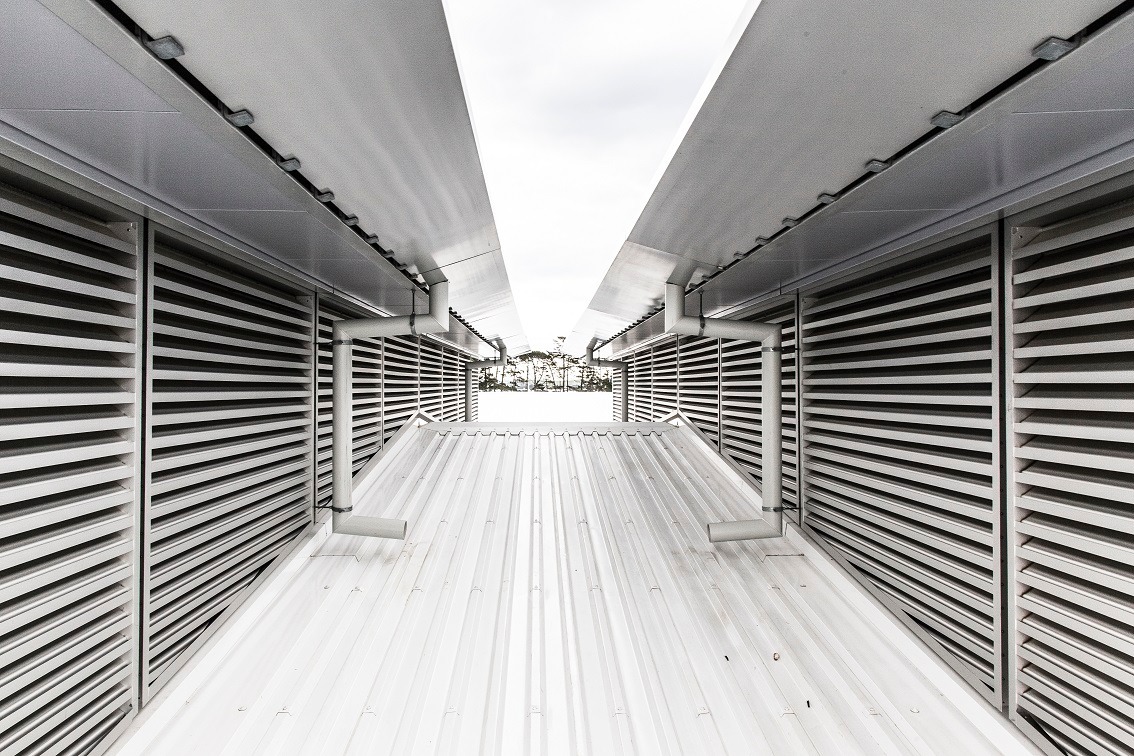Aluminium louvres provide an almost perfect blend of aesthetic appeal and functional performance. Made from a material that’s infinitely recyclable and naturally protects itself by forming an oxide layer to resist corrosion, aluminium louvres will continue looking good after decades of use. But just how good will be impacted by how they have been treated. That treatment choice is not necessarily straightforward though and there are trade-offs to consider. So consider them we will, beginning with powder coating…
Powder Coated Ventilation Louvres
A dry finishing process, powder coating sprays electrically charged particles onto a pre-treated aluminium surface. These particles are essentially finely ground pigment and/or resin, which is then melted and fused onto the aluminium by curing at a high temperature.
It’s not quite as easy as it sounds though and powder coating involves a lengthy process, beginning with preparing the aluminium. Any residue such as dust, dirt and grease has to be systematically removed before a cleaning agent such as ethanol or acetone is applied These are used because they leave no residue on the surface after evaporation. Next, the cleaned aluminium louvres are left to dry before the actual powder coating process can begin.
Before the powder coat can be sprayed, the particles have to be charged via a process of ionisation (corona application) or triboelectric (or electrokinetic) charging. Then, using either a manual powder spray pistol or one configured automatically in a spray booth, the powder cloud is forced through the nozzles and onto the aluminium, where it adheres electrostatically to the surface, forming a layer of powder coating.
It’s important the spraying process is smooth with a consistent application of powder coating that never excessively covers the aluminium. If that happens, the excess powder coat can create a bumpy, textured surface. It will also make the next stage more difficult as the powder coated aluminum now needs curing. This is when the aluminum louvres are placed in an oven at temperatures up to 200℃ for 5 to 30 minutes.
Following curing, powder coated louvres exhibit a high quality finish that improves the durability of the aluminium. They are resistant to chemicals, moisture, ultraviolet rays and extreme weather. There’s also a reduced risk of scratching, chipping, corrosions and other issues which can cause louvres to look worn.
This isn’t to say that the highly durable louvres are now impervious to UV rays or weather though, as very little is. They will still require regular maintenance using the correct solvents, such as white spirit, methylated spirits and turpentine. These mild solvents should be used every 3 months unless in a marine or industrial environment, when more regular cleaning is recommended. It’s important not to leave mild solvents on too long though. And never use harsh solvents such as acetates, Methyl Ethyl Ketone and Petrol products, along with any alcohol based cleaners or those with acidic or alkali ingredients.
With careful maintenance, powder coated louvres will continue to look great for years, the powder coating process having increased the durability of the louvres.
Anodised Aluminium Louvres
Whereas powder coating adds a surface layer of pigment or resin to the aluminium louvre, anodising changes the surface chemistry of the louvre itself to create a decorative and protective film of aluminium oxide.
As before, the aluminum louvres have to be prepared and cleaned. In this case, it means bathing the louvres in an electrolytic solution such as sulphuric acid, which is readied with aluminum sheet cathodes before the louvres are lowered into the solution and a positive charge is applied (making the louvres the anode). The sulphuric acid then begins to decompose as aluminium ions travel towards the cathode but are met at the anode surface by oxide/hydroxide ions - forming a barrier layer of aluminium oxide.
Add a higher voltage for a longer period and the layer gets thicker, with the depth measured in microns. This can be used to personalise the anodisation levels to suit the usage environment. For example, a layer of 15 microns is suitable for the majority of buildings but a factory close to the ocean might want the added security of using anodised aluminum louvres with a 25 micron layer. Either way, we should note the aluminium oxide layer produced during the anodising process is rated 9 out of 10 on the Mohs Hardness Scale. For reference, diamonds score 10.
As expected, this means anodised louvres are especially durable. They won’t scratch, crack or corrode, and when a coloured finish is specified, the colour is so deeply embedded that it won’t peel or fade.
As with powder coated louvres though, this doesn’t mean Mother Nature can be completely defeated and the added durability does still require regular maintenance. This maintenance is similar to cleaning windows and if the louvres are neglected then all it usually takes to restore the finish is a solvent like kerosene and a soft cloth.
Harsh abrasives should be avoided as they can damage the protective film on the louvres, and when that happens there’s no coming back.
Are Powder Coated Louvres or Anodised Louvres More Durable?
The answer is both powder coated and anodised louvres are incredibly durable, and with regular maintenance there’s no real reason to pick one over the other, so there’s no reason to answer this question.
But If you did want a definitive answer, then anodised louvres have a slight edge and choosing them for more extreme marine environments makes sense. That said, remember we said there’s a tradeoff to consider? That’s because there is.
Anodised louvres are typically only available in limited colour palettes and most have a gentle shine to them (matt colours require an extra processing step). By contrast, powder coat colours are virtually unlimited and even an authentic looking woodgrain powder coat finish.
That’s the trade-off, as much as there is one. Both powder coated and anodised louvres are incredibly durable and the choosing between them really comes down to aesthetics.
Can't choose? Contact us and we'll help you decide.
